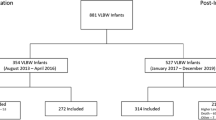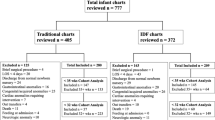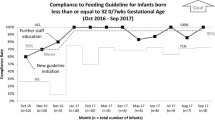Abstract
Objective:
To study whether a cue-based clinical pathway for oral feeding initiation and advancement of premature infants would result in earlier achievement of full oral feeding.
Study Design:
Age of achievement of full oral intake was compared for two groups of preterm infants; a prospective study group vs historic cohort controls. Study infants had oral feedings managed by nurses using a clinical pathway that relied on infant behavioral readiness signs to initiate and advance oral feedings. Controls had oral feedings managed by physician orders.
Result:
Fifty-one infants (n=28 study and n=23 control) were studied. Gender distribution, gestational age, birth weight and ventilator days were not different between groups. Study infants reached full oral feedings 6 days earlier than controls (36±1 3/7 weeks of postmenstrual age (PMA) vs 36 6/7±1 4/7 weeks of PMA, P=0.02).
Conclusion:
The cue-based clinical pathway for oral feeding initiation and advancement of premature infants resulted in earlier achievement of full oral feeding.
This is a preview of subscription content, access via your institution
Access options
Subscribe to this journal
Receive 12 print issues and online access
$259.00 per year
only $21.58 per issue
Buy this article
- Purchase on Springer Link
- Instant access to full article PDF
Prices may be subject to local taxes which are calculated during checkout



Similar content being viewed by others
References
McCain GC . An evidence-based guideline for introducing oral feeding to healthy preterm infants. Neonatal Netw 2003; 22: 45–50.
Lemons PK . From gavage to oral feedings: just a matter of time. Neonatal Netw 2001; 20: 7–14.
Hack M, Estabrool M, Robertson S . Development of sucking rhythm in preterm infants. Early Hum Dev 1985; 11: 133–140.
Lau C, Sheena HR, Shulman RJ, Schanler RJ . Oral feeding in low birth weight infants. J Pediatr 1997; 130: 561–569.
Simpson C, Schanler RJ, Lau C . Early introduction of oral feeding in preterm infants. Pediatrics 2002; 110: 517–522.
Collinge JM, Bradley K, Perks C, Rezny A, Topping P . Demand vs. scheduled feedings for premature infants. JOGN Nurs 1982; 11: 362–367.
Saunders R, Baker-Friedman C, Stramoski P . Feeding preterm infants: schedule or demand? J Obstet Gynecol Neonatal Nurs 1990; 20: 212–218.
McCain GC, Gartside PS, Greenberg JM, Lott JW . A feeding protocol for healthy preterm infants that shortens time to oral feeding. J Pediatr 2001; 139: 374–379.
Pridham K, Brown R, Sondel S, Green C, Wedel NY, Lai HC . Transition time to full nipple feeding for premature infants with a history of lung disease. J Obstet Gynecol Neonatal Nurs 1998; 27: 533–545.
Kliethermes PA, Cross ML, Lanese MG, Johnson KM, Simon SD . Transitioning preterm infants with nasogastric tube supplementation: increased likelihood of breastfeeding. J Obstet Gynecol Neonatal Nurs 1999; 28: 264–273.
Meier PP, Engstrom JL, Fleming BA, Streeter PL, Lawrence PB . Estimating milk intake of hospitalized preterm infants who breastfeed. J Hum Lact 1996; 12: 21–26.
Pridham K, Kosorok MR, Greer F, Carey P, Kayata S, Sondel S . The effects of prescribed versus ad libitum feedings and formula caloric density on premature infant dietary intake and weight gain. Nurs Res 1999; 48: 86–93.
Shaker CS . Nipple feeding preterm infants: an individualized, developmentally supportive approach. Neonatal Netw 1999; 18: 15–22.
Dupont W . Statistical Modeling for Biomedical Researchers. New York: Cambridge, 2002.
McGrath JM, Medoff-Cooper B . Alertness and feeding competence in extremely early born preterm infants. Newborn Infant Nurs Rev 2002; 2: 174–186.
Craig CM, Lee DN, Freer YN, Laing IA . Modulations in breathing patterns during intermittent feeding in term infants and preterm infants with bronchopulmonary dysplasia. Dev Med Child Neurol 1999; 41: 616–624.
Gewolb IH, Bosma JF, Taciak VL, Vice FL . Abnormal developmental patterns of suck and swallow rhythms during feeding in preterm infants with bronchopulmonary dysplasia. Dev Med Child Neurol 2001; 43: 454–459.
Casaer P, Daniels H, Devlieger H, De Cock P, Eggermont E . Feeding behaviour in preterm neonates. Early Hum Dev 1982; 7: 331–346.
Gewolb IH, Vice FL, Schwietzer-Kenney EL, Taciak VL, Bosma JF . Developmental patterns of rhythmic suck and swallow in preterm infants. Dev Med Child Neurol 2001; 43: 22–27.
Eichenwald EC, Blackwell M, Lloyd JS, Tran T, Wilker RE, Richardson DK . Inter-neonatal intensive care unit variation in discharge timing: influence of apnea and feeding management. Pediatrics 2001; 108: 928–933.
Acknowledgements
We thank the University of Utah Newborn Intensive Care Unit nurses, nurse practitioners and occupational therapists for their important contributions to this research. We also acknowledge the work of Leanne Seckinger, Vickie Brunstetter, and Carol Henderson on the development and implementation of the clinical pathway. This work was supported, in part, by The Children's Health Research Center.
Author information
Authors and Affiliations
Corresponding author
Rights and permissions
About this article
Cite this article
Kirk, A., Alder, S. & King, J. Cue-based oral feeding clinical pathway results in earlier attainment of full oral feeding in premature infants. J Perinatol 27, 572–578 (2007). https://doi.org/10.1038/sj.jp.7211791
Received:
Revised:
Accepted:
Published:
Issue Date:
DOI: https://doi.org/10.1038/sj.jp.7211791
Keywords
This article is cited by
-
Effect of cue-based feeding on time to nipple feed and time to discharge in very low birth weight infants
Scientific Reports (2023)
-
Non-Pharmacological and Non-Surgical Feeding Interventions for Hospitalized Infants with Pediatric Feeding Disorder: A Scoping Review
Dysphagia (2023)
-
Cue-based feeding and short-term health outcomes of premature infants in newborn intensive care units: a non-randomized trial
BMC Pediatrics (2022)
-
Early skin contact combined with mother’s breastfeeding to shorten the process of premature infants ≤ 30 weeks of gestation to achieve full oral feeding: the study protocol of a randomized controlled trial
Trials (2021)
-
Oral-feeding guidelines for preterm neonates in the NICU: a scoping review
Journal of Perinatology (2021)



